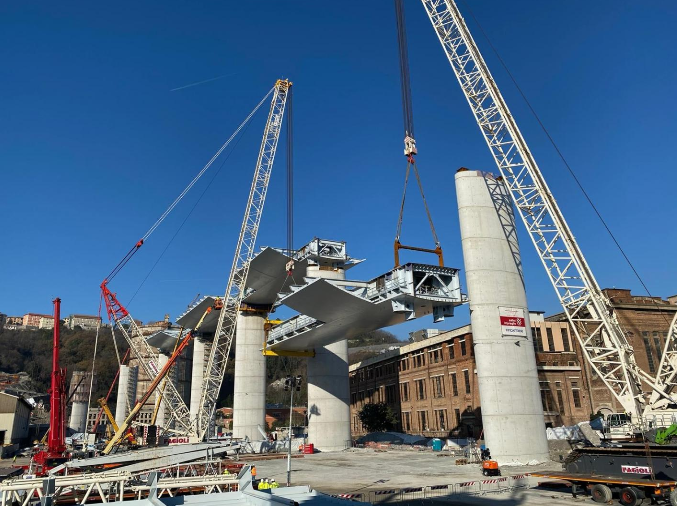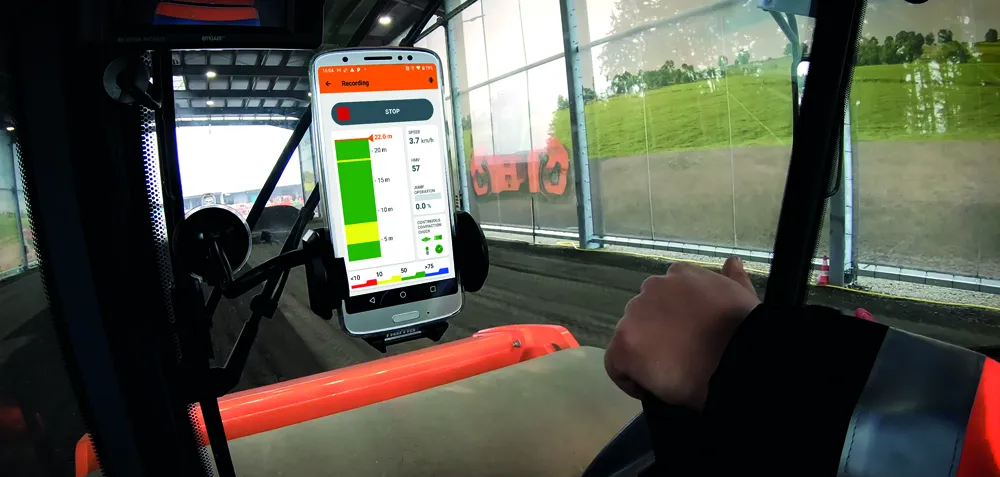
Another milestone was reached several weeks ago for the Genoa Bridge replacement project. Simultaneous installation of two deck sections was carried out to bring to more than 900m the structure’s installed deck length, according to PerGenova, the joint venture in charge of the project.
Thanks to the recently implemented fast-track model that has seen various activities proceed simultaneously throughout the construction site, a section of the deck, 51m-long and weighing 410tonnes, was raised 40m up between Piers 12 and 13 on the east side of the riverbed.
Also, a 15m, 114tonne section of Abutment A was hoisted between Piers 1 and 2 on the west side with the help of a temporary tower.

PerGenova JV – Salini Impregilo and Fincantieri – is also proceeding with work on the already-installed part of the structure and preparing to raise the last four sections of the deck to complete the bridge. Technicians and workers are maintaining a high production rate while respecting the safety measures in order to complete the structure with all the sections of the deck installed by the end of April, says the JV.
“It is the success of a marvellous, cohesive team,” said Nicola Meistro, general manager domestic operations at Salini Impregilo and chief executive of PerGenova.
“All of our people have shown a great ability to adapt to this new context. It is thanks to them and the suppliers and the rest of the production chain that work alongside us every day in full respect of the rules, that the Genoa Bridge is a model for Phase 2 for all of Italy, a country of people who in times of difficulty know how to roll up their sleeves in a show of confidence and courage.”
The construction site of the new bridge is deploying extraordinary measures as a result of the coronavirus. These include measuring the body temperature of every worker who enters the site, distributing hand sanitisers and installing disinfectant gel dispensers, enforcing the safe distance rule, cleaning and disinfecting work sites and common areas and reducing the number of people who travel in the same vehicle to and from the site.
In addition, all workers have protection masks whose use is obligatory when they are close to their colleagues. These measures are but a summary of what has been adopted at the site, much like those at sites elsewhere in the world operated by the Salini Impregilo Group as it confronts the health emergency with a task force that is operating at a global level.
Work proceeds on the access ramp of the highway as well as the complex operation to prepare the base of the installed deck. Around 8,000m³ of concrete will be poured, starting at both ends of the bridge at the same time and working towards the centre. This activity will be done round the clock.
“We are giving it everything we’ve got and speeding up the work as much as possible,” said Francesco Poma, senior project manager for Italy with Salini Impregilo and project manager of the bridge work.

The bridge is illuminated every evening with three lasers beaming the colours of the Italian flag to create a Bridge of Light to express Salini Impregilo’s solidarity with the country and transmit to Genoa a message of hope for the future.
The Genoa Bridge is also a test case for Progetto Italia, according to the company. PerGenova is the listed consortium established by Fincantieri and Salini Impregilo to design and build the Polcevera viaduct (Genoa Bridge) on Italy's A10 motorway.
“The joint venture represents an example of collaboration between two large companies that complement each other and put to the service of Genoa and Italy their unique expertise, acquired through many years of global experience.” Construction site activities take place with three eight-hour shifts, “a rhythm necessary for the work to be completed in record time”, explains the project’s website.
According to the website dedicated to Project Italy, the scheme will contribute to GDP (gross domestic product) growth – construction already accounts for around 8% of Italian GDP. It will support employment, save between 300,000-400,000 jobs and be a driving force for the entire sector through more than 30 related economic sectors. It will guarantee the construction of ongoing and future infrastructure projects in Italy. Productivity levels will be increased and there will be support for innovation, sustainability and safety within the construction sector.









